Behold the humble onion. It’s the foundation of so many delicious dishes, from stews and soups to stir-fries and salads. But let’s be real here: growing onions can be a real tear-jerker. No, I’m not talking about the emotional toll of watching your beloved vegetables sprout and thrive. I’m talking about the fact that chopping onions is basically an invitation for your eyes to stage a full-blown waterworks display. It’s like your tear ducts are auditioning for the role of Niagara Falls. But fear not! With a little know-how, you can grow onions without shedding a single tear (unless you’re really emotionally invested in your garden, in which case all bets are off). So, dry your eyes, and keep reading for your complete guide on how to grow onions.
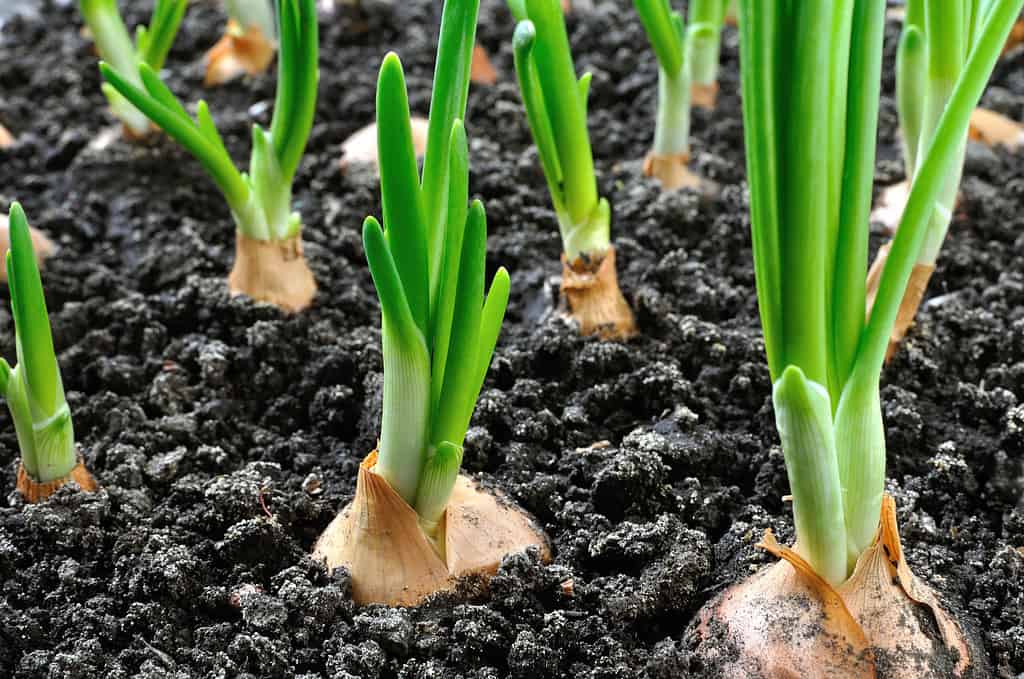
With a little know-how, you can grow onions without shedding a single tear.
©yuris/Shutterstock.com
What are Onions?
Onions (Allium cepa) are bulb vegetables that belong to the Allium family, which also includes garlic, leeks, chives, and shallots. Onions are characterized by their papery outer layer and their distinctive pungent taste and smell. They come in different varieties, ranging from small and sweet to large and spicy. They are used in a wide variety of cuisines around the world. Onions are also packed with nutrients, including vitamin C, vitamin B6, and dietary fiber, making them a healthful addition to any diet. They can be eaten raw, cooked, or pickled, and are a staple ingredient in many dishes.
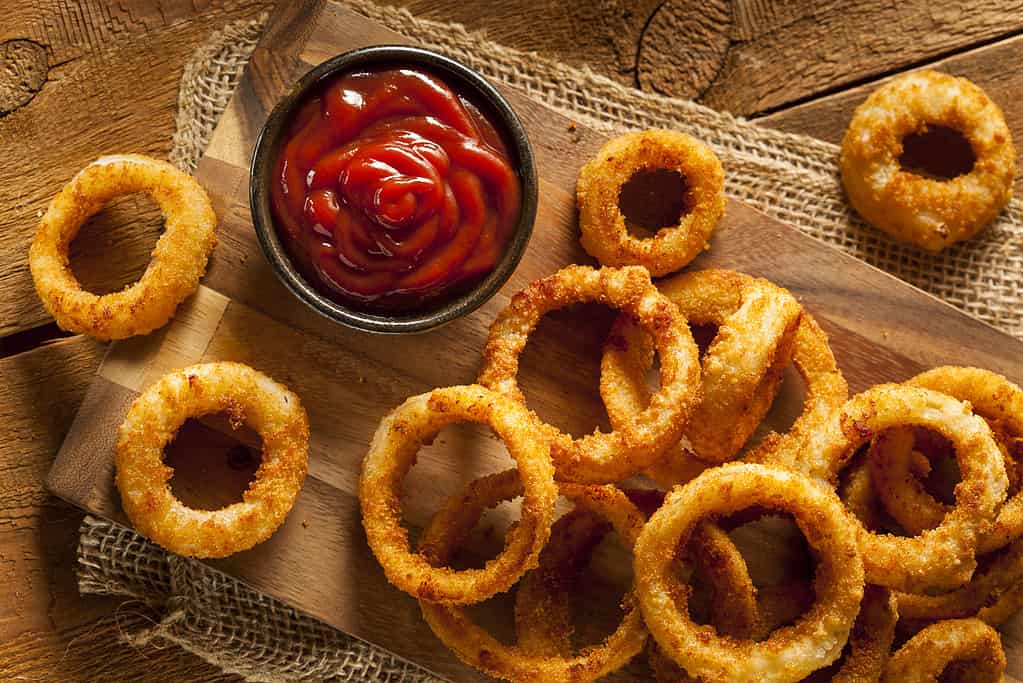
Onions can be eaten raw, cooked, or pickled, and are a staple ingredient in many dishes, like these onion rings.
©Brent Hofacker/Shutterstock.com
How to Grow Onions: Selecting a Variety
There are many different varieties of onions, with estimates ranging from hundreds to over a thousand. Some of the most common types of onions include red onions, yellow onions, and white onions. These different varieties can vary in size, shape, flavor, and color. Red onions tend to be milder and sweeter than yellow onions, while white onions have a more delicate flavor and a thinner, papery skin.
Some onions are better suited for cooking, while others are best eaten raw in salads or sandwiches. Overall, the variety of onions available provides a wide range of options for cooking and eating. And, of course, you don’t have to settle for just one variety! Onions are relatively compact plants that don’t require a lot of space. So, if you can’t seem to choose one variety, plant a mix!
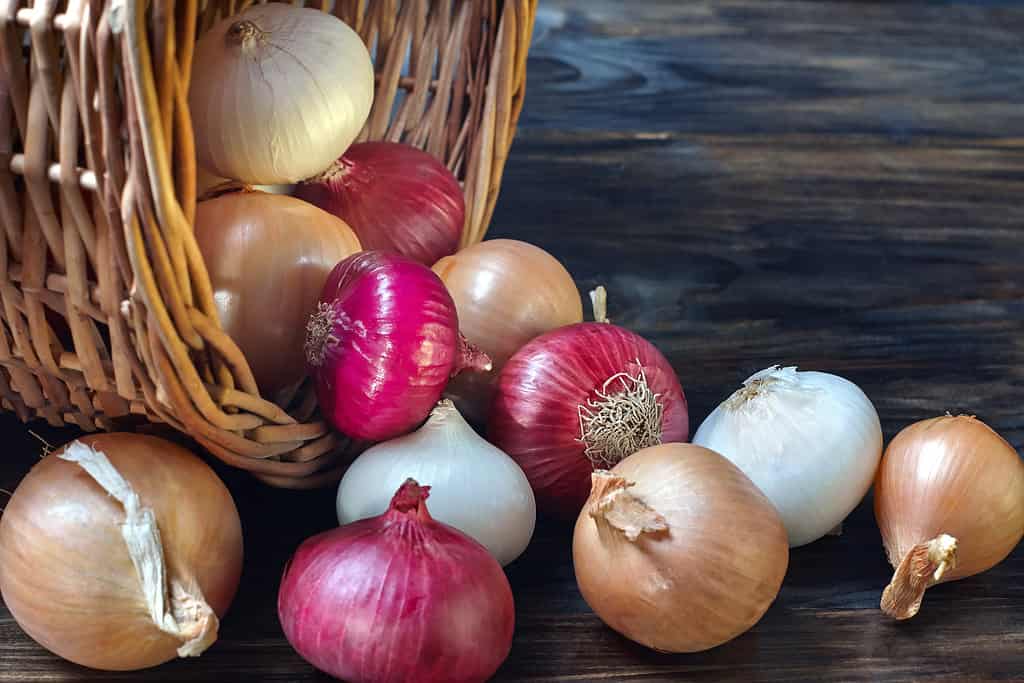
Some of the most common types of onions include red onions, yellow onions, and white onions.
©Svecha-65/Shutterstock.com
How to Grow Onions: Selecting a Method
There are two principal methods for growing onions. Onions can be grown either from seed or from onion sets, which are small immature onion bulbs. Growing onions from seed and growing onions from sets both have their advantages and disadvantages. Starting onions from seed allows for a wider selection of onion varieties and can be less expensive than purchasing sets. Onion seeds can be started indoors in the winter and then transplanted into the garden in the spring, allowing for an earlier harvest. However, growing onions from seed requires more time and attention to detail, as onion seeds can be finicky to germinate and require consistent moisture and temperature.
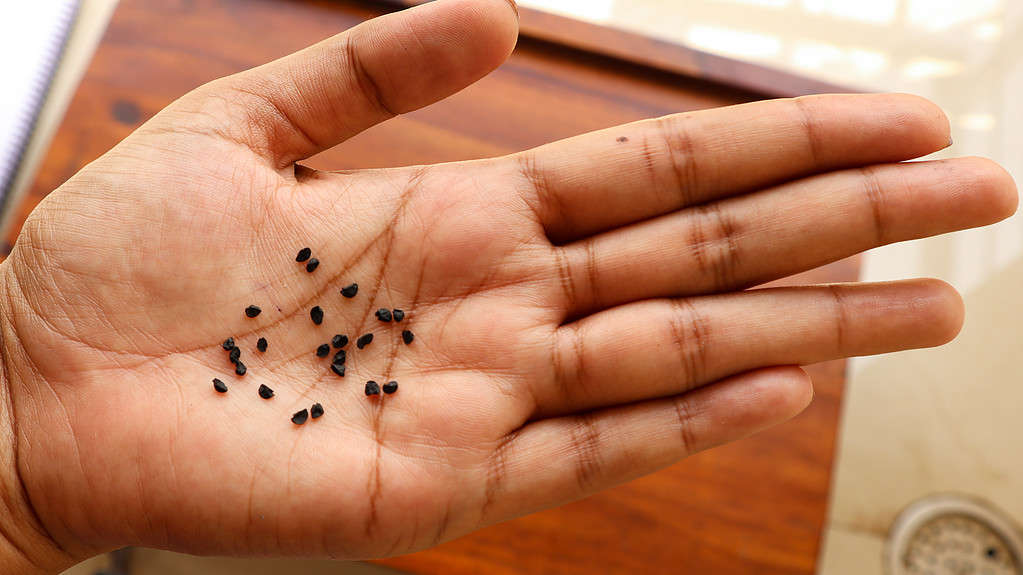
Starting onions from seed allows for a wider selection of onion varieties and can be less expensive than purchasing sets.
©Tottochan/Shutterstock.com
On the other hand, growing onions from sets is a quicker and easier process. Sets are small onion bulbs that are already partially grown. They can be planted directly into the garden in the spring and require less maintenance than onions grown from seed. However, sets can be more expensive than seed and may have a limited variety selection. Ultimately, the choice between growing onions from seed and growing onions from sets comes down to personal preference, budget, and gardening goals.

Sets are small onion bulbs that are already partially grown.
©Irisha_S/Shutterstock.com
Preparing the Bed
The location of the onion bed should be in a sunny area with well-draining soil. The soil should be amended and enriched with organic matter like compost or aged manure. Before planting, the soil should be loosened to a depth of 6 to 8 inches (15 to 20 cm. This can be accomplished using a garden fork or tiller. The soil should also be tested to ensure a pH level between 6.0 and 7.5, which is the ideal range for onions.
If necessary, the soil pH can be adjusted by adding lime to raise it or sulfur to lower it. You can learn how to test your soil’s pH level here. Once the soil has been prepared, the onion sets or transplants can be planted. A depth of 1 inch (2.5 cm) and spacing of 4 to 6 inches (10 to 15 cm) apart is recommended. The soil should be kept moist and weeds should be removed regularly to prevent competition for nutrients and water.

Before planting, the soil should be loosened to a depth of 6 to 8 inches (15 to 20 cm) using a garden fork or tiller.
©Singkham/Shutterstock.com
How to Grow Onions: Starting from Seed
When growing onions from seed, you can get either start seed indoors before the last frost, or wait until after the last frost, sowing the seed directly in the garden.
Starting Seed Indoors
If you’re using the indoor method, it is recommended to start onion seeds 8 to 10 weeks before the last frost date in your area. This will allow the seedlings enough time to mature and develop a good root system before being transplanted outdoors.
To start onion seeds indoors, sow the seeds in a seed-starting mix and keep the soil evenly moist. Onion seeds require warm soil, responding best to temperatures of 70°F (21°C), to germinate. If you live in a cold, drafty house, use can a heat mat to help maintain a consistent temperature.
Once the onion seedlings have emerged, they should be kept under bright fluorescent or LED grow lights for at least 12 hours per day. As the seedlings grow, they should be fertilized regularly with a balanced fertilizer to promote healthy growth.
About two weeks before transplanting the onion seedlings outdoors, they should be hardened off by gradually exposing them to outdoor conditions. This can be done by placing the seedlings outside for a few hours each day. Gradually increase the amount of time they spend outdoors over the course of a week or two.

Onion seedlings emerge 7-10 days after planting, depending on soil temperature, moisture level, and seed quality.
©VVVproduct/Shutterstock.com
Directly Sown Seed
You can sow onion seeds directly outdoors after the last frost date in your area. In fact, many gardeners prefer to sow onion seeds directly into the soil instead of starting them indoors, as it can simplify the growing process and eliminate the need for transplanting seedlings.
However, it’s important to make sure that the soil temperature is warm enough for onion seeds to germinate. Onion seeds typically require a minimum soil temperature of 50°F (10°C) to even consider germinating.
To sow onion seeds directly into the soil, prepare the planting area by removing any weeds or debris and tilling the soil to a depth of about 4-6 inches (10-15 cm). Then, create shallow furrows in the soil about 1/4 inch (0.6 cm) deep and spaced about 12 inches (30 cm) apart. Sow the onion seeds thinly along the furrow, and cover them with a thin layer of soil. Keep the soil evenly moist and weed-free during the germination period. Onion seedlings emerge 7-10 days after planting, depending on a variety of factors. Seedling emergence is influenced by soil temperature, moisture level, and seed quality.
Once the seedlings have established a second set of leaves, thin them to 4-6 inches (10-15 cm) apart. Onions grown from seed typically take 100-120 days to harvest.

Onions grown from seed typically take 100-120 days to harvest.
©nnattalli/Shutterstock.com
How to Grow Onions: Planting Sets
When planting onion sets, the general rule of thumb is to plant them at a depth of about 1 inch (2.5 cm), with the pointed end facing up. This depth allows the sets to establish roots and grow properly without being exposed to the surface.

When planting onion sets, the general rule of thumb is to plant them at a depth of about 1 inch (2.5 cm), with the pointed end facing up.
©Niran Phonruang/Shutterstock.com
In terms of spacing, onion sets should be planted about 4-6 inches (10-15 cm) apart from each other, and rows should be spaced about 12 inches (30 cm) apart. This spacing will allow the onions to grow and develop without competing with each other for nutrients and space. Onions grown from sets can be ready for harvest in as little as 80-100 days.
How to Grow Onions: Container Gardens
Yes! Onions can be grown in containers, as long as the container is large enough to accommodate the onion bulb and has good drainage. A container with a depth of at least 8 inches (20 cm) and a width of 12 inches (30 cm) is recommended for growing onions.
When growing onions in containers, it is important to use a well-draining potting mix and to keep the soil moist. Growing onions in containers requires more frequent watering and fertilization than onions grown in the ground, but otherwise, the process is the same as starting from seeds or sets. Onions grown in containers may not reach the same size as onions grown in the ground, but they can still be a tasty and rewarding addition to a home garden with limited space.
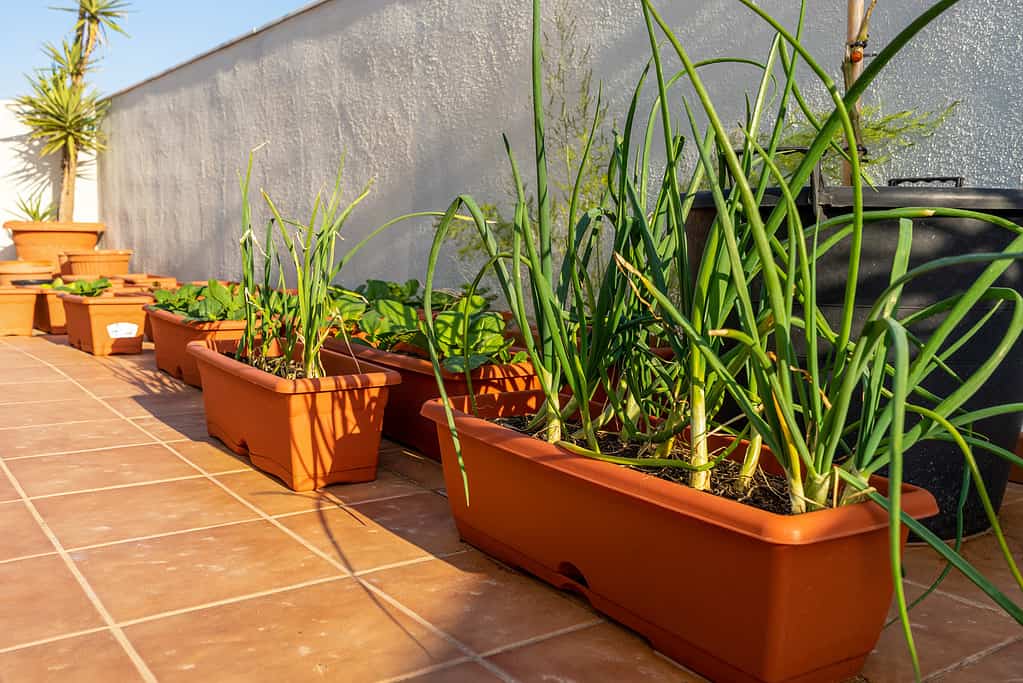
Onions can be grown in containers, as long as the container is large enough to accommodate the onion bulb and has good drainage.
©andres barrionuevo lopez/Shutterstock.com
USDA Hardiness Zones
Onions can be grown in zones 3-11, with different varieties being more suited to specific zones.
In general, onions prefer cooler temperatures and do well in zones with a long, cool growing season Popular varieties like Yellow Sweet Spanish and Walla Walla are well-suited to cooler climates and can be grown in zones 3-9.
Other varieties, such as Granex and Texas 1015, are better adapted to warmer climates and can be grown in zones 8-11. It’s important to choose onion varieties that are adapted to your specific climate and growing conditions to ensure the best results. If you are unsure of your USDA Hardiness Zone, check here.
Five Fabulous Facts about Onions
- The average American eats approximately 20 pounds of onions annually.
- The official state vegetable of Georgia is the Vidalia onion.
- 3/4 of the onions produced globally are yellow.
- Onions are comprised of 89% water
- A chemical compound called syn-Propanethial S-oxide (C3H6OS) is responsible for teary eyes when cutting onions.

A chemical compound called syn-Propanethial S-oxide (C
3H
6OS) is responsible for teary eyes when cutting onions.
©TommyStockProject/Shutterstock.com
How to Grow Onions: A Word about Bulb Division
In addition to growing onions from seeds and sets, there is another method of onion propagation called bulb division. This technique involves dividing mature onion bulbs into smaller sections, which can then be planted to produce new onion plants. Propagation by bulb division is not as commonly used for onions as starting from seed or planting sets. This is because onion bulbs are not always well-suited for division. Dividing bulbs can sometimes result in uneven growth and smaller size. Bulb division is a useful method of propagation for gardeners who want to multiply their onion stock without the hassle of starting from seed or purchasing sets. However, it’s important to note that not all onion varieties are suitable for bulb division. Care should be taken not to damage the roots or growing points of the onion sections during the division process.
To divide an onion bulb, the foliage should be cut back to between 1-2 inches (2.5-5 cm) above the bulb. Then the bulb should be carefully dug up and gently separated into individual sections, making sure that each section has some of the root system attached. These sections can then be planted in the garden.
The photo featured at the top of this post is © yuris/Shutterstock.com
Thank you for reading! Have some feedback for us? Contact the AZ Animals editorial team.







